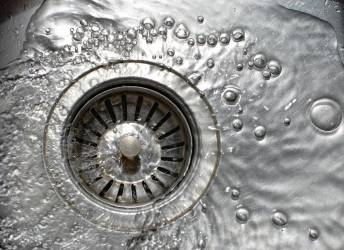
If you’re doing a thorough spring cleaning, you might want to give some thought to cleaning your drains, especially if you’ve noticed a soapy residue around your bath drain, an oily coating on the bottom of your kitchen sink, or perhaps a new water stain in your laundry room drain. These are indicators of a drain slowed by dirt and debris, which can become a clogged drain if you don’t take steps to clean it.
Kitchen drains
All kinds of organic matter pass through your drains in the process of cleaning and preparing food, especially if you use a garbage disposal. However, disposals are not designed to handle pasta, large amounts of peelings, or fibrous vegetables like celery. Remnants of improperly ground food matter can build up in your drain and pipes.
Grease is another culprit. Most people know it’s a bad idea to dispose of grease or cooking oils through the kitchen sink – instead, you should dispose of it through a compost pile, collect it in an old coffee can or cardboard milk container then put it in the trash, or even recycle your cooking oil. Often, however, despite our best efforts drippings and residue can make their way down the sink and dirty up your drain.
Bathroom drains
In your bathroom, hair and soap are the biggest offenders of clogged drains and pipes. It helps to install screen baskets to your bath and shower drains, especially if you have hard water (which requires more soap) or someone in the household with long hair.
Cleaning those drains
- Plunger – If a drain has debris that needs to be cleared, a plunger is your first line of defense. A standard cup plunger with a red bell is most commonly used for sinks or tubs, but it needs a flat surface to form a proper seal.
- Liquid cleaner – Some think a chemical drain cleaner is the answer, but most popular drain cleaners you buy contain lye. While lye can dissolve soap scum and hair very quickly, be careful not to use too much. These chemical cleaners can also be harmful to the delicate plumbing found in many older homes, even in small amounts. Instead, there’s a safe, organic way to clean your drains as a maintenance measure.
- Home remedies – Pour a half cup of salt and half a cup of baking soda into your drain. Follow with half cup of vinegar and let it foam for about 60 seconds. Rinse down with at least a half-gallon of boiling water
- Ice – A good maintenance cleaner for your garbage disposal is to freeze a special tray of ice cubes that are half vinegar and half water. Vinegar is acidic and cleans bacteria in the disposal and drain, while the ice works to literally scrape the grease away.
Keeping the lines clear of hair, grease, or clingy matter is the best way to keep your drains clean. If dirty drains ever become problematic clogs, it’s best to call the expert plumbers here at Michael’s Plumbing for professional drain cleaning. Schedule your next appointment today!

